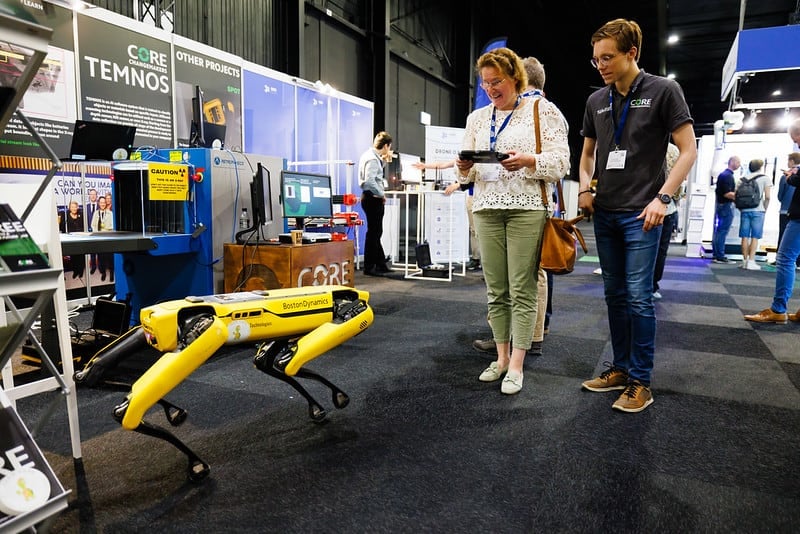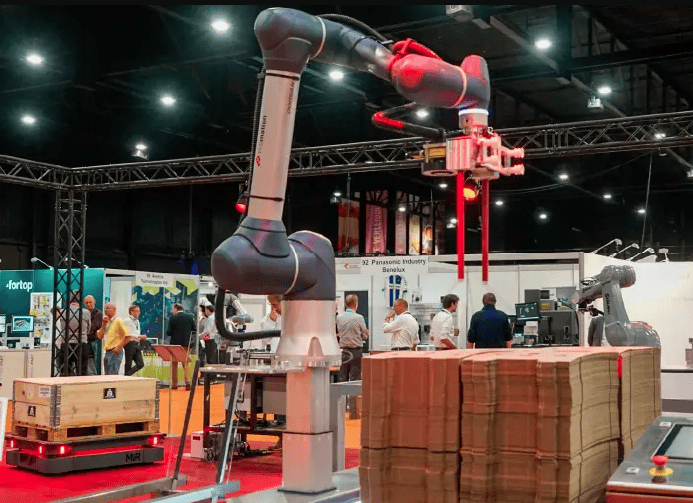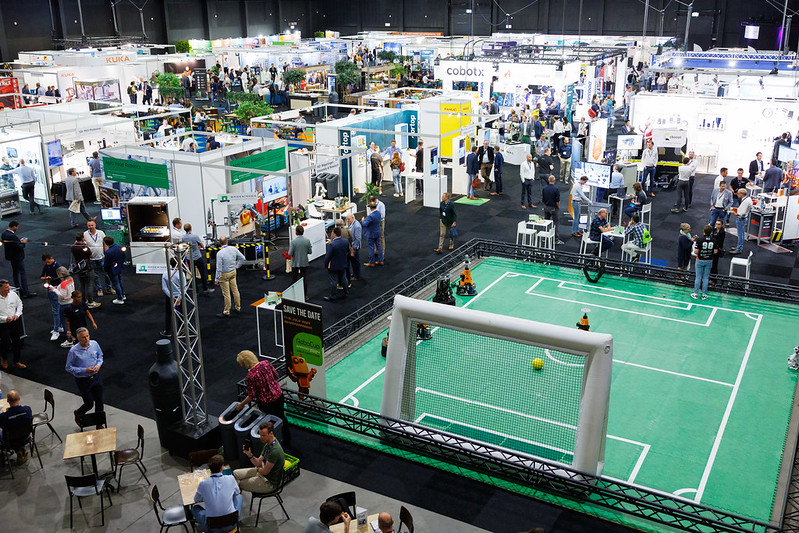
From a robotic arm that precisely assembles a part, to a production line that uses vision technology to perform precise quality control to a hopping robot dog and robots playing soccer. The Vision, Robotics & Motion trade show captures the imagination. The futuristic-looking scenes with large and small robots are already technically feasible. But large-scale application remains (for now) out of the question. How do entrepreneurs implement elements such as vision technology in their processes? What does the future look like? This fair was created to answer that question. Various companies – from start-ups to multinationals – are forming Industry 4.0. Industry 4.0 is the fourth industrial revolution in which automation and robotization are essential.
- The Vision, Robotics & Motion trade fair shows the industry the possibilities of automation and robotization.
- Much innovations are already technologically possible, only the implementation (on a large scale) is still difficult for many companies.
- Cooperation – both within an industry and beyond – can boost the implementation of automation and robotization.
Inspiration
“This fair is meant to bring people together. To talk business, but also to inspire each other,” says Bert-Jan Woertman, managing director at Mikrocentrum, the Vision, Robotics & Motion organizer. Inspiration is plentiful. Over a hundred exhibitors will showcase their latest, most significant, and most innovative technologies.
Solving a shortage of employees
For example, automation specialist Balluf brought a whole mobile home to show all their different sensors and systems. Their technology is used in various sectors, from manufacturing companies to logistics and agriculture. At some companies, sensors automatically restock products in the warehouse, while others focus on predictive maintenance, predicting maintenance on machines (especially the rotating parts) even before something breaks down. Such applications allow for a more streamlined production process with lower error rates.

Many companies consider automation and robotisation an essential solution to the massive labour shortage. Robots, for example, can do monotonous work, as it is becoming increasingly more work to find people for that job. “Robots are going to make our work more fun,” says Thijs Dorssers, cluster manager for Robotics at High Tech NL. “Due to the corona crisis and the continuing labour shortage, the number of robots is growing significantly.” He outlines that the Netherlands has been a leader in agro for decades. Robots can also make a difference in this sector.
Harvesting robots on standby
Dutch universities and universities of applied sciences are doing a lot of research into using robots in industry and society. For example, Wageningen University & Research (WUR) is developing several robots to pick fruits and vegetables using vision technology. Technically, this is quite a challenge. After all, the robot must move autonomously over the land, detect ripe fruit, grab it with the proper force, and pick it off the plant. Several projects are at an advanced stage; for example, picking robots are almost ready to enter the fields and greenhouses.

The difficult transition from knowledge to practice
A lot needs to be done before these steel assistants drive across the farmyard. The transition from technological knowledge to daily practice is too big for many parties involved. Money and time always play a significant role in these dilemmas. Cooperation is the keyword. Cooperation between companies in industry associations is essential, as are collaborations between industry associations in different sectors. For example, Dorssers sees essential cooperation between the high-tech industry and agriculture. Various robots can be converted from an industrial setting to an application in agriculture or horticulture. He argues that the knowledge and experience gained earlier can then be used efficiently for new applications.
Erik Seijner, operations director of HPS Industrial B.V., also talks about making the new technology accessible in front of his machine at the fair. The company develops vision technology for various industrial applications. With this technology, you can, for example, quickly and accurately check whether all screws have been correctly screwed into an object. “Our technology does not work with pictures – as is usual – but with a video,” he says. In addition, the company has created a tool to analyze the retrieved data and train the systems efficiently. So companies no longer have to do their programming to implement the technology into their process. That makes it accessible to smaller companies that can’t handle implementation.

Deep learning
Training robots is an important issue. Every production line or application is different. Robots must be precisely tuned to the needs and requirements of the company working with them. In science, this is an important research topic. Klaas Dijkstra, lecturer at NHL Stenden University of Applied Sciences focuses, for example, on training vision technology for the agribusiness sector. Deep learning plays a vital role in this, Dijkstra explains. Previously, data were analyzed and labelled using pictures. For example, a banana is always long and yellow, and an apple is consistently round and red. But what about a yellow pear? That’s hard to pinpoint. Using deep learning, the system compares objects’ characteristics to make distinctions.
Good data must be available here. Otherwise, the system can teach itself incorrect comparisons. Dijkstra has figured something out for that. He generates training data using DALL-E, an AI-based image generator. For example, he instructs the system to create different, realistic photos of apple trees. He can use those photos to train a picking robot to recognize the ripe apples on a tree. That makes data collection a lot easier.
Strengthening cooperation
At Vision, Robotics & Motion, many innovative solutions were presented that can move the industry forward. To achieve exemplary implementation, cooperation within the triple helix needs to improve, Dirk van Meer, CEO of CORE Changemakers, concluded the exhibition. With his student team, he helps entrepreneurs with circularity issues, such as recycling batteries. “We still overthink our field and interests. We can innovate even better and faster by paying extra attention to the collaborations between knowledge institutions, governments and companies.”
The next edition of the Vision, Robotics & Motion trade fair is scheduled for June 5 and 6, 2024.

